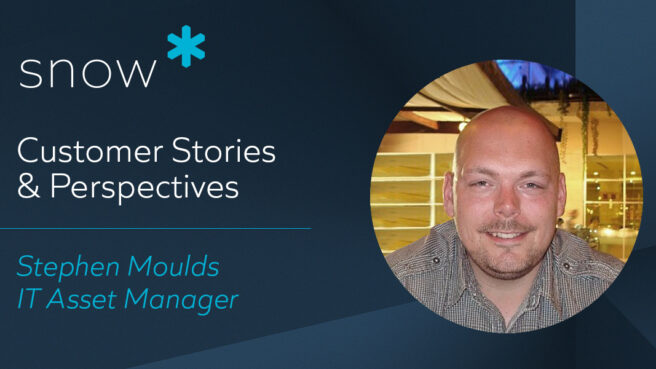How Keeping It Simple Saved Money and Reduced Risk

Like many software asset managers (SAMs), Stephen Moulds stumbled into the role partly by accident. Given his highly regarded tenure in IT service delivery, he was asked to bring a service mentality to the SAM discipline for Johnson Matthey, a multinational chemicals company headquartered in London. Though Stephen had little previous experience with SAM, he and his team saved the company £1 million in a very short timeframe.
How did he do it? Stephen started with the basics and pretended to explain licensing models to his 10-year-old son.
We recently sat down with Moulds to talk about his career journey, which includes roles with IBM, Marshall Aerospace and Defense Group and Johnson Matthey. While at Johnson Matthey, he gained expertise in the field of SAM in part by working with the Snow Software SAM solution.
How did you get into SAM and succeed?
MOULDS: Within my company, the SAM function was there but it just wasn’t working. Over two short years, we had some brilliant success and I think the reason behind that success was that I took it back to the basics. I had a simple understanding of SAM at the time and because of that, I was able to build a simple but solid foundation for improvement.
It came down to even silly things like understanding the different types of core licenses. I wanted to put that into basics that even my 10-year-old son could understand. Then it became a question of how we could deliver those core three or four different licensing models to our customers without risking our compliance position. Once I got my head wrapped around that, it became about putting basic processes in place to allow that functionality to happen.
What SAM processes do you recommend?
MOULDS: One of the toughest things about good SAM strategies is knowing where to start. For us, we focused on keeping it simple. Rather than attacking all the applications we had (which was a lot), we started with our top 10-15 software vendors based on volume of usage. That might be Microsoft, Oracle, IBM — any vendor for which usage is high, and therefore, so is your cost. We started with those and brought them under control. By doing so, we then had a framework to manage the rest of our licenses across our software estate.
Next, to get a handle on our global software estate, one of the things I found to be important was appropriate vendor engagement. Sometimes, calling up a vendor and asking about licenses can be a red flag to that vendor and an audit could follow. Instead, tell them you’re looking to renew your licenses and consolidate with them. You can get the information you need this way without explicitly telling them you don’t know what you don’t have. It’s important to protect the organization while you go through this discovery phase.
We also knew this foundational work was good for a point-in-time view. While we were gathering data on our top 10-15, people were out there buying more software in the background. To address that challenge, we made sure all new entitlements were added to our framework. With the Snow Software SAM solution, we had a single source of truth for all our data. It became almost self-managing once we had all the data in there. If you’re going to succeed as a SAM leader, you also have to manage your data daily. Consistent misinformation ends up leading to mistrust.
Lastly, once we had our top vendors under control, we could look at the tail spend. No one ever really knows what that is; it’s made up of bits of stuff. For larger enterprises, it may total £ 3 or 4 million. For us, we had many different project management tools when we only needed one. Understanding and consolidating our portfolio into a pre-approved catalog combined with other similar services meant we were able to save the company £1 million.
Lessons from the trenches
Taking a SAM program from zero to 100 in just two years taught Moulds and his team a few important lessons that are valuable for anyone working to improve their own program.
MOULDS: SAM can sometimes be a forgotten function within IT. Today, we are an important team that can save the organization significant money and reduce risk. It’s important for SAM managers and the discipline to evolve from being a compliance organization to a function of delivery of software on time to the business. We’ve shifted from being the stereotypical bean counters to a position of strength — one that works in partnership with all areas of the business.
But you can’t do this without good data. From the cybersecurity team wanting to know about out-of-date software to the operations team needing to know who is using what, SAM is about delivery and supporting an ever-changing business. If you feed the Snow Software SAM solution with good data, it will do much of the work for you. Without such a tool, you can’t keep on top of where you stand. You can’t deliver.
To learn more about our featured guest Stephen Moulds, check out his bio on LinkedIn.
This post is part of a series of blogs that highlight IT practitioners and their on-the-job experiences, diverse backgrounds and what it means to work in IT today.
If you’d like to share your story with Snow readers or nominate an ITAM/SAM star to tell theirs, please send an email to kathleen.shepherd@snowsoftware.com.